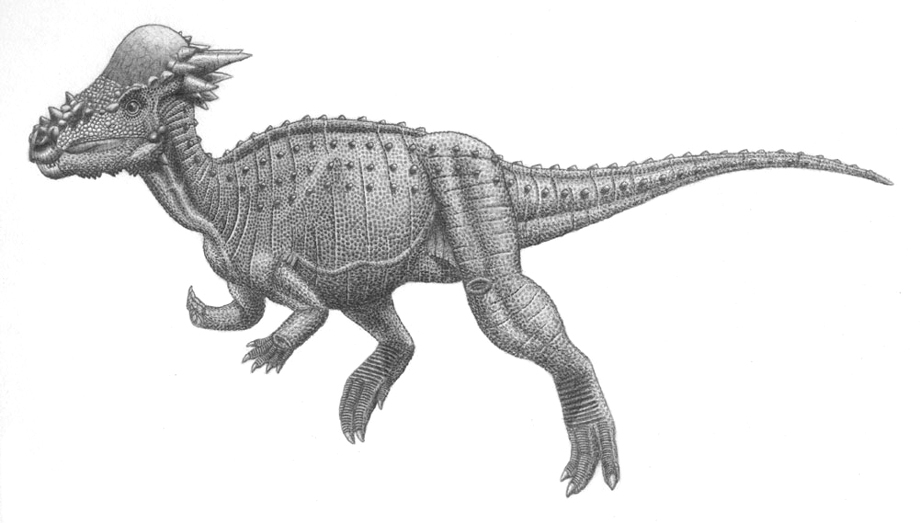- Pachycephalosauria
Taxobox
name = Pachycephalosaurs
fossil_range = ?Middle Jurassic -Late Cretaceous

image_size = 200px
image_caption = Undescribed pachycephalosaur, informally referred to "Pachycephalosaurus wyomingensis"
regnum =Animal ia
phylum = Chordata
classis = Sauropsida
superordo =Dinosaur ia
ordo =Ornithischia
subordo =Cerapoda
infraordo = Pachycephalosauria
infraordo_authority = Maryańska & Osmólska, 1974
familia = Pachycephalosauridae
familia_authority = Sternberg, 1945
subdivision_ranks = Genera
subdivision = See text.
synonyms =
* Homalocephalidae Dong, 1978Pachycephalosauria (pronEng|ˌpækɨˌsɛfələˈsɔriə, Greek for 'thick headed lizards') is a
clade ofornithischian dinosaur s. Well-known genera include "Pachycephalosaurus ", "Stegoceras ", "Stygimoloch ", and "Dracorex ". Most lived during the LateCretaceous Period, in what is nowNorth America andAsia . They were allbipedal ,herbivorous /omnivorous animals with thick skulls. In some species the skull roof is domed and several inches thick; in others it is flat or wedge-shaped. The dome may be surrounded by nodes (for instance, "Pachycephalosaurus "), spikes ("Stygimoloch "), or both ("Dracorex ").Candidates for the earliest known pachycephalosaur include "Ferganocephale adenticulatum" from the
Middle Jurassic Period of what is now Kyrgyzstan and "Stenopelix valdensis" from theEarly Cretaceous Period of what is nowGermany , although Sullivan doubted that either of these species are pachycephalosaurs.Sullivan, R.M. (2006). "A taxonomic review of the Pachycephalosauridae (Dinosauria: Ornithischia)." "New Mexico Museum of Natural History and Science Bulletin", 35: 347-365.]Paleobiology
The function of the thickened skull roof has been heavily debated. It has been frequently asserted that individuals may have rammed each other head-on, as do modern-day
mountain goat s andmusk oxen . It is also suggested that pachycephalosaurs could make their head, neck, and body horizontally straight, in order to transmit stress during ramming. However, in no known dinosaur can the head, neck, and body be oriented in such a position. Instead, the cervical and anterior dorsal vertebrae of pachycephalosaurs show that the neck was carried in an "S"- or "U"-shaped curve.cite journal |last=Carpenter |first=Kenneth |authorlink=Kenneth Carpenter |year=1997 |title=Agonistic behavior in pachycephalosaurs (Ornithischia:Dinosauria): a new look at head-butting behavior |journal=Contributions to Geology |volume=32 |issue=1 |pages= 19–25 |url=https://scientists.dmns.org/sites/kencarpenter/PDFs%20of%20publications/pachy%20head%20butting.pdf |format=pdf]Also, the rounded shape of the skull would lessen the contacted surface area during head-butting, resulting in glancing blows. Other possibilities include flank-butting, defense against predators, or both. The relatively wide width of pachycephalosaurs (which would protect vital internal organs from harm during flank-butting) and the squamosal horns of the "
Stygimoloch " (which would have been used to great effect during flank-butting) add credence to the former.Classification
Most pachycephalosaurid remains are not complete, usually consisting of portions of the frontoparietal bone that forms the distinctive dome. This can make
taxonomic identification a difficult task, as the classification of genera and species within "Pachycephalosauria" relies almost entirely on cranial characteristics. Consequently, improper species have historically been appointed to the clade. For instance, "Majungatholus ", once thought to be a pachycephalosaur, is now recognized as a specimen of the abelisaurid theropod "Majungasaurus ". And "Yaverlandia ", another dinosaur initially described as a pachycephalosaurid, has also recently been reclassified as a theropod (Naish in Sullivan 2006). Further complicating matters are the diverse interpretations ofontogenetic and sexual features in pachycephalosaurs.Taxonomy
The Pachycephalosauria was first named as a suborder of the Order
Ornithischia byTeresa Maryańska andHalszka Osmólska in 1974. They included within it only one family, the Pachycephalosauridae.Maryańska, T. and Osmólska, H. (1974). "Pachycephalosauria, a new suborder of ornithischian dinosaurs." "Palaeontologica Polonica", 30: 45-102.] Later researchers, such as Michael Benton, have ranked it as an infraorder of the SuborderCerapoda , which unites theceratopsia ns and ornithopods.Benton, Michael J. (2004). Vertebrate Palaeontology, Third Edition. Blackwell Publishing, 472 pp. ] In 2006, Robert Sullivan published a re-evaluation of pachycephalosaur taxonomy. Sullivan considered attempts to restrict Maryańska and Osmólska naming of Pachycephalosauria redundant with their Pachycephalosauridae, since they were diagnosed by the same anatomical characters. Sullivan also rejected attempts byPaul Sereno , in hisphylogenetic studies, to re-define Pachycephalosauridae to include only "dome-skulled" species (including "Stegoceras" and "Pachycephalosaurus"), while leaving more "basal" species outside that family in Pachycephalosauria. Therefore, Sullivan's use of Pachycephalosauridae is equivalent to Sereno and Benton's use of Pachycephalosauria.Sullivan diagnosed the Pachycephalosauridae based only on characters of the skull, with the defining character being a dome-shaped "frontoparietal" skull bone. According to Sullivan, the absence of this feature in some species assumed to be primitive led to the split in classification between domed and non-domed pachycephalosaurs; however, discovery of more advanced and possibly juvenile pachycephalosaurs with flat skulls (such as "Dracorex hogwartsia") show this distinction to be incorrect. Sullivan also pointed out that the original diagnosis of Pachycephalosauridae centered around "flat to dome-like" skulls, so the flat-headed forms should be included in the family.
The following
taxonomy represents Sullivan's 2006 classification.* Family Pachycephalosauridae
** "Alaskacephale "
** "Colepiocephale "
** "Goyocephale "
** "Hanssuesia "
** "Homalocephale "
** "Prenocephale " (incl. "Sphaerotholus ")
** "Stegoceras " (incl. "Ornatotholus ")
** "Tylocephale "
** Tribe Pachycephalosaurini
*** "Dracorex " - possible juvenile form of "Pachycephalosaurus"
*** "Pachycephalosaurus "
*** "Stygimoloch " - possible juvenile form of "Pachycephalosaurus"Erik Stokstad,"SOCIETY OF VERTEBRATE PALEONTOLOGY MEETING: Did Horny Young Dinosaurs Cause Illusion of Separate Species?", "Science" Vol. 18, 23 Nov. 2007, p. 1236; http://www.sciencemag.org/cgi/content/full/318/5854/1236]
* Pachycephalosauridae "incertae sedis" (uncertain placement)
** "Wannanosaurus "
* "Nomina dubia" (doubtful names)
** "Gravitholus "
** "Ferganocephale "
** "Heishansaurus " (probably anankylosaur )
** "Micropachycephalosaurus "
** “Stegoceras” "bexelli"Note that Sullivan considered "
Stenopelix " (sometimes assigned to the Pachycephalosauria as the most basal member) not diagnostic enough to be assigned to this group, and placed is as Ornithischia "incertae sedis".Phylogeny
Wikimedia Foundation. 2010.
